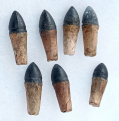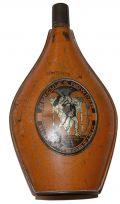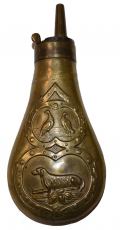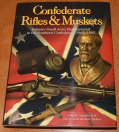site search
online catalog
Firearms
Showing 51 to 100 out of 256
SCARCE JOSLYN “TRANSITIONAL” MODEL 1862 CARBINE
The Joslyn carbine Model 1862, often referred to as the First Model, was a cavalry weapon that used an innovative pivoting breechblock system invented and patented by Massachusetts gun designer… (490-3802). Learn More »
GETTYSBURG MICHIGAN CAVALRY BRIGADE SPENCER RIFLE: SECOND DELIVERY “COPELAND” SPENCER, SERIAL #1811 WITH CONFEDERATE “Q” CLEANED AND REPAIRED STAMP
M1860 Spencer Army Rifles are highly sought after and one falling in the serial number range for issue in Custer’s Michigan Cavalry Brigade before Gettysburg is a holy grail for many. This one has… (172-6073). Learn More »
J.M. COOPER DOUBLE-ACTION NAVY MODEL REVOLVER
Cooper began making guns in Pittsburgh from circa 1850s-1864 then moved to Philadelphia and made guns there from 1864-69, approximately 15,000 of all models. This is the “Second model” as made in… (2024-2059). Learn More »
$550.00
ON HOLD
COLT 1851 NAVY REVOLVER
Colt's belt pistol was a market favorite dating from the California Gold Rush and during its long production run, several variations were manufactured. Without a doubt, the 1851 Navy was one of the… (2024-1951). Learn More »
A RARE SURVIVOR: EARLY-WAR CONFEDERATE MARKED BRITISH P53 ARTILLERY CARBINE #1500 WITH A TENNESSEE PROVENANCE
British artillery carbines were used by both Confederate cavalry and infantry: in October 1862 Jeb Stuart wanted to exchange rifles carried by some his troopers for “Enfield carbines (artillery) in… (846-571). Learn More »
NICE WHITNEY PLYMOUTH NAVY RIFLE, DATED 1863
These rifles are often referred to as Plymouth Rifles because the initial batch of rifles, from which the contract pattern was derived, were tested on board the USS Plymouth from 1856-1858 under the… (490-6953). Learn More »
INTERESTING MARTIALLY MARKED COLT MODEL 1851 NAVY REVOLVER
This revolver, likely due to damage, is made up out of two original revolvers! One of the serial numbers, 66862, on the wedge, barrel, frame, and cylinder, dates half of this revolver to early 1857… (2024-637). Learn More »
G. T. DAVIDSON AND CO. FULL STOCK PERCUSSION RIFLE
This attractive gun is an antique full-stock percussion long rifle with a Tyler Davidson Lock, made circa the 1840s in Ohio. The barrel is heavy and octagonal. The bore is .43 caliber and while dull,… (172-6067). Learn More »
HOLSTER FOR A FIVE-INCH COLT POCKET REVOLVER
This is a brown leather belt holster in good condition for a Colt .32 caliber percussion pocket revolver with a 5-inch barrel. The holster is a simple three-piece construction of the body and flap in… (172-5400). Learn More »
$375.00
Originally $475.00
TOOLED LEATHER MODEL 1851/1861 NAVY SIZE REVOLVER HOLSTER
Several holsters of this configuration for navy size revolvers are illustrated in Meadows and are seen in period photos. They key point of identification is the use of an elongated flap extending in… (172-5395). Learn More »
$650.00
Originally $825.00
COLT MODEL 1849 POCKET REVOLVER
The Model 1849 Pocket Revolver, a replacement for the Baby Dragoon, was the most widely produced of any Colt percussion pistol. Nearly 340,000 were manufactured during a 23-year production run that… (2024-1950). Learn More »
$495.00
ON HOLD
SHORT BARREL LEFAUCHEUX PINFIRE REVOLVER
With protruding firing pins the cartridges for pinfire revolvers seem to be asking for trouble, but their early appearance gave them a lead in the market for self-contained metallic cartridges with no… (490-7191). Learn More »
BAVARIAN PERCUSSION REVOLVER BY REINHARD STAHL
This five-shot percussion has a robust solid frame reminiscent of Adams revolvers and a loading assembly like a Colt. It is profusely engraved with floral vines and scrolls on the frame and hammer,… (836-22). Learn More »
$635.00
Originally $750.00
UNALTERED JENKS “MULE EAR” NAVY CARBINE
A very fine carbine, this Jenks Navy-marked carbine made by the N. P. Ames Company of Springfield, Massachusetts is one of only 4,250 made between 1843 and 1846. This rifled, .54 caliber shoulder… (490-3971). Learn More »
VERY NICE KETLAND PERCUSSION TRADE PISTOL
This lovely single shot pistol features a 9.25” long round, tapered barrel of approximately .60 caliber. Top flat at breech is marked “LONDON” amid light engraving. Birmingham private view and… (490-3446). Learn More »
$895.00
ON HOLD
SCARCE JOSHUA AND CHARLES BARSTOW 1808 CONTRACT MUSKET WITH BAYONET
Joshua Barstow and son Charles of Exeter, NH, signed a U.S. contract for 2,500 muskets 21 October 1808, with 500 to be delivered to Fort Constitution at Portsmouth, NH, annually over a five-year term.… (1037-15). Learn More »
$2,700.00
Originally $3,250.00
SOLD
ORIGINAL M1816 TYPE I UNALTERED FLINTLOCK MUSKET BY POMEROY WITH NORTH CAROLINA MARKINGS
Longarm specimen is an original M1816, dated 1818. Although the lock does not bear the maker’s name we know it was made by Pomeroy of Pittsfield, Massachusetts. Musket is a .69 caliber, single shot… (1037-05). Learn More »
$2,750.00
Originally $3,450.00
SOLD
HALF STOCK PERCUSSION TARGET RIFLE – J. V. GEIGER
This beautiful rifle was made by gunsmith J.V. Geiger and features many lovely characteristics. The heavy, octagonal .50 caliber barrel measures just under 36” and, while the bore is dull, the… (2024-562). Learn More »
$495.00
ON HOLD
SPRINGFIELD 1838 DATED M1816 PERCUSSION CONVERSION MUSKET FROM THE YORK SPRINGS, PA., G.A.R. POST, WITH MILITARY RACK MARKINGS
A good example of a classic early Civil War musket: a Model 1816 converted from flintlock to percussion in the early 1850s to bring it up to par with the new, percussion M1842 muskets. These are .69… (1202-429). Learn More »
WELL USED UNTOUCHED 1862 DATED M1861 SPRINGFIELD WITH CONFEDERATE C&R INITIALS AND SOLDIER’S NAME ON STOCK
This is an untouched M1861 Springfield Rifle Musket in well-used condition bearing both the “A” and “Q” stamps associated with arms passing through the Confederate Ordnance cleaning and repair… (490-7186). Learn More »
.44 CALIBER PAPER CARTRIDGES FOR COLT, REMINGTON, & OTHER “ARMY” REVOLVERS
We have a quantity of Civil War cartridges for .44 caliber “Army” revolvers. These are paper cartridges with the short, New Model Colt bullet in them made by the Colt Cartridge Works. All… (2024-1527). Learn More »
PAIR OF CONSECUTIVELY NUMBERED IVORY-GRIPPED LARGE IRON-TRIGGERGUARD COLT M1851 NAVIES
Formerly in the collections of the Texas Civil War Museum, this pair of consecutively numbered Colt 1851 Navies are Late Third Models, numbered 64964 and 64965, dating to late 1856 or early 1857,… (1179-700K). Learn More »
$11,900.00
ON HOLD
IDENTIFIED COLT 1862 POLICE REVOLVER
In 1861 Colt introduced two new pocket model revolvers in the more powerful .36 caliber chambering. Until that time, all of Colt’s “Pocket” guns had been .31 caliber, or in the case of some of… (2024-638). Learn More »
$2,750.00
ON HOLD
NICE M1841 HARPERS FERRY MISSISSIPPI RIFLE
Over 75,000 Model 1841 Rifles were manufactured at both the U.S. Armory at Harpers Ferry, Virginia, and under private contract. Mississippi troops serving under future Confederate President Jefferson… (1142-67). Learn More »
$4,750.00
ON HOLD
NICE ALLEN AND WHEELOCK NAVY LIPFIRE REVOLVER
This is a very nice example of the rare .36cal "Navy" version of the rare "Lip Fire" Revolvers made by Ethan Allen and his brother-in-law Thomas Wheelock in Worcester, Mass. In 1856 the two formed a… (2022-2433). Learn More »
CONNECTICUT ARMS AND MANUFACTURING CO. HAMMOND .44 RIMFIRE “BULLDOG” PISTOL, WITH WOOD GRIPS
Most of the production models of the single-shot .44 caliber Hammond “Bulldog” seem to have been made with composite grips (often simply, but inaccurately referred to as gutta-percha.) This one… (490-7039). Learn More »
VERY SCARCE ARROW AND STAR MARKED MOORE DERINGER
The Moore deringer was the first of the large caliber metallic cartridge deringers according to Flayderman. They were made by the Moore Patent Firearms Company in Brooklyn from about 1860 to 1865 when… (490-7035). Learn More »
TIN POWDER FLASK FROM HERCULES POWDER COMPANY
This gun powder tin is in the shape of a flask, painted orange, and with a small belt loop on the back. Measures 8.5” tall, 4.5” wide. Features the oval Hercules graphic on the front and… (490-7181). Learn More »
$145.00
ON HOLD
UNIQUE OKLAHOMA STAMPED COLT MODEL 1860 REVOLVER
Colt’s 1860 Army revolver, otherwise known as the New Army revolver, was the most common sidearm issued during the American Civil War. The U.S. Cavalry adopted it readily in 1860 and it remained the… (172-5928). Learn More »
A PERSUASIVE POCKET PISTOL: CONNECTICUT ARMS AND MANUFACTURING CO. HAMMOND .44 RIMFIRE “BULLDOG” PISTOL, CA. 1865-1868
This robustly constructed, single-shot .44 caliber Hammond “Bulldog” rates about very good for condition, showing about 10-15% finish: some thin blue mixed with gray on the barrel, blue shifted to… (490-7038). Learn More »
RARE WAR OF 1812 SIMEON NORTH U.S. MODEL 1813 ARMY PISTOL
This is a very professional and very well done reconversion to flint of a very hard to find US military pistol, in strong condition, showing very good metal, sharp lock, proof and mating markings, and… (431-69). Learn More »
SINGLE ACTION STARR M1863 “IMPROVED ARMY” REVOLVER
Starr revolvers were surpassed in production numbers only by Colt and Remington during the Civil War and are thus a key piece in Civil War revolver or cavalry collection. In fact, along with… (431-68). Learn More »
$1,200.00
ON HOLD
BEAUTIFUL, RARE PLANT’S PATENT MERWIN AND BRAY REVOLVER
This “Army” pattern revolver was manufactured in an obscure .42 caliber, firing an exclusive “cup primed” cartridge. Approximately 8,000 of these pistols were produced during the mid-1860’s… (2022-2431). Learn More »
$975.00
ON HOLD
EXCEPTIONALLY RARE BALTIMORE CITY POLICE ENGRAVED COLT POCKET REVOLVER
The venerable Colt Model 1849 Pocket Revolver could be found the world over before and during the Civil War. Combining the adequate power of .31 caliber with a healthy powder charge, and a small… (490-3167). Learn More »
BRITISH FLINTLOCK PISTOL BY DUTTON
Iron mounted flintlock pistol with a .69 caliber, smoothbore, octagonal barrel 8-inches long. There are London view and proofmarks on the left barrel flat near the breech, the maker’s name… (2024-1775). Learn More »
$995.00
ON HOLD
“CENTURY OLD BELGIAN FLINTLOCK PISTOL”
We take our heading from the 1927 Bannerman catalog entry for this pistol. Aside from two small illegible marks on the right butt, we see no exterior markings and have not taken it apart, but the… (2024-1774). Learn More »
ATTRACTIVE GERMAN SILVER MOUNTED FULL STOCK PERCUSSION RIFLE WITH DEFREES LOCK
This is a very good looking hunting rifle with nicely tiger-striped applied graining, mounted with a brass buttplate and the other fittings, both decorative and functional, in German silver. The side… (2024-1848). Learn More »
VERY GOOD, NEAR FINE IVORY GRIP GUSTAVE YOUNG STYLE ENGRAVED COLT M1851 NAVY MADE IN 1859
This very pretty Colt Navy is serial number 92278, giving it a manufacture date of 1859, and is an early 4th Model, with no capping groove and larger triggerguard. The serial numbers match throughout… (1179-674). Learn More »
$7,500.00
ON HOLD
DOG AND PHEASANT MOTIF SLOPING CHARGER POWDER FLASK FOR REMINGTON REVOLVERS
This pattern of flask is associated with cased Remington Army and Navy revolvers. The embossed motifs feature a pair of standing pheasants at top, who seem to have met their fate in bottom panel,… (490-6975). Learn More »
CONNECTICUT ARMS AND MANUFACTURING CO. HAMMOND .44 RIMFIRE “BULLDOG” PISTOL, CA. 1865-1868
This is a strong example of the standard production with 4-inch barrel, gutta-percha (thermoplastic) checkered grips, chambered for the .44 rimfire cartridge. These pistols were elegantly styled by… (490-7040). Learn More »
VERY SCARCE US GOVERNMENT PURCHASE MERRILL RIFLE
This Merrill breechloading rifle is one of just 566 contracted for by the US government in December 1861 and delivered from August through December 1862, inspected and marked by Zadock Butt, and known… (490-7012). Learn More »
.58 CALIBER RIFLE MUSKET CARTRIDGE
Regulation tan paper cartridge for the U.S. .58 caliber rifled musket. This is the typical "minie ball" cartridge of the American Civil War. Known as the "regulation" or "American military" style of… (2024-2131). Learn More »
SCARCE ALLEN AND WHEELOCK CENTER-HAMMER LIPFIRE .36 CALIBER NAVY REVOLVER
Ethan Allen, with his various partners, was a significant figure in the history of American firearms manufacture though overshadowed in popular (well, at least collector) memory by Colt, Remington,… (490-6720). Learn More »
NICE, COMPLETE EARLY-MID 18TH CENTURY FRENCH MUSKET LOCK
This pattern of lock and its construction typifies those found on French muskets or fusils prior to the advent of the famed m1777 “Charleville” musket. This is most likely a 1728 - 1766 pattern… (766-2040). Learn More »
USED HANDSEWN CONFEDERATE WARTIME MANUFACTURE HOLSTER
This holster features hallmarks of Confederate wartime manufacture, including a press brass button closure, hand stitched seams, hand stitched closure flap, and hand stitched belt loop attachment. The… (1202-190). Learn More »
US MODEL 1842 RAMROD SPRING BAR
Good clean condition. [ad] [ph:L] ~~~~~~~~~~~~~~~~~~~~~~~~~~~~~~~~~~~ THIS ITEM, AS WITH ALL OTHER ITEMS AVAILABLE ON OUR WEB SITE, MAY BE PURCHASED THROUGH OUR LAYAWAY PROGRAM. CLICK HERE FOR OUR… (689-88). Learn More »
$75.00
Originally $100.00
FLINTLOCK MUSKET VENT PICK AND BRUSH SET
This was an essential military gun tool during the flintlock era: a wire pick for clearing the vent hole of the musket and small horsehair brush for cleaning out the priming pan. Overall length is… (2024-1346). Learn More »
1ST EDITION COPY OF “CONFEDERATE RIFLES & MUSKETS” BY MURPHY & MADAUS FROM THE LIBRARY OF THE LATE DEAN S. THOMAS
Very fine condition copy of “CONFEDERATE RIFLES & MUSKETS: INFANTRY SMALL ARMS MANUFACTURED IN THE SOUTHERN CONFEDERACY 1861-1865” by John M. Murphy and Howard Michael Madaus published in… (2022-1304). Learn More »
CONNECTICUT ARMS AND MANUFACTURING CO. HAMMOND .44 RIMFIRE “BULLDOG” DERINGER, CA. 1865-1868
This is the standard configuration for the Connecticut Arms Hammond “Bulldog” pistol, a single-shot .44 cal. Deringer with 4-inch barrel, that would have proved a persuasive at short range. This… (490-7036). Learn More »
CONNECTICUT ARMS AND MANUFACTURING CO. HAMMOND .44 RIMFIRE “BULLDOG” DERINGER, CA. 1865-1868
This attractive, single-shot Deringer rates very good or near fine for condition with smooth metal, all original parts, sharp lettering, nice grips and near 30 percent or so original finish showing as… (490-6876). Learn More »
Showing 51 to 100 out of 256
Most Popular
Historical Firearms Stolen From The National Civil War Museum In Harrisburg, Pa »
Theft From Gravesite Of Gen. John Reynolds »
Selection Of Unframed Prints By Don Troiani »
Fine Condition Brass Infantry Bugle Insignia »
British Imported, Confederate Used Bayonet »
Scarce New Model 1865 Sharps Still In Percussion Near Factory New »
featured item
ID’D P1855 MOUNTED SERVICES MUSICIAN’S SHELL JACKET – WILLIAM OSWALD, 4th PENNSYLVANIA CAVALRY
William Oswald resided in Northampton County, Pennsylvania when he enlisted on August 15th, 1861. On that same day, he mustered into Company “A” of the 4th Pennsylvania Cavalry as a Bugler. Initially, the regiment was organized at Pittsburgh,… (1268-776). Learn More »




















































